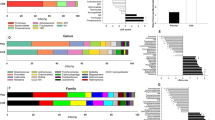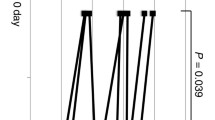Abstract
Objectives
The aim of this study was to determine the effects of short-term xylitol gum chewing on the salivary microbiota of children.
Materials and methods
The study was a randomised, controlled, double-blind trial. Healthy children used xylitol chewing gum (xylitol group, n = 35) or sorbitol chewing gum (control group, n = 38) for 5 weeks. The daily dose of xylitol/sorbitol was approximately 6 g/day. At baseline and at the end of the test period, unstimulated and paraffin-stimulated saliva were collected. The microbial composition of the saliva was assessed using human oral microbe identification microarray (HOMIM). Mutans streptococci (MS) were plate cultured.
Results
As judged by HOMIM results, no xylitol-induced changes in the salivary microbiota took place in the xylitol group. In the control group, Veillonella atypica showed a significant decrease (p = 0.0001). The xylitol gum chewing decreased viable counts of MS in both stimulated (p = 0.006) and unstimulated (p = 0.002) saliva, but similar effects were also seen in the control group.
Conclusions
The use of xylitol gum decreased MS, in general, but did not change the salivary microbial composition.
Clinical relevance
Short-term consumption of xylitol had no impact on the composition of the salivary microbiota, but resulted in a decrease in the levels of MS.



Similar content being viewed by others
References
Alanen P, Isokangas P, Gutmann K (2000) Xylitol candies in caries prevention: results of a field study in Estonian children. Community Dent Oral Epidemiol 28:218–224
Mäkinen KK (2011) Sugar alcohol sweeteners as alternatives to sugar with special consideration of xylitol. Med Princ Pract 20:303–320
Campus G, Cagetti M, Sale S, Petruzzi M, Solinas G, Strohmenger L, Lingström P (2013) Six months of high-dose xylitol in high-risk caries subjects—a 2-year randomised, clinical trial. Clin Oral Inv 17:785–791
Honkala E, Honkala S, Shyama M, Al-Mutawa SA (2006) Field trial on caries prevention with xylitol candies among disabled school students. Caries Res 40:508–513
Milgrom P, Ly KA, Tut OK, Mancl L, Roberts MC, Briand K, Gancio MJ (2009) Xylitol pediatric oral syrup to prevent dental caries: a double-blind randomized clinical trial of efficacy. Arch Pediatr Adolesc Med 163:601–607
Zhan L, Cheng J, Chang P, Ngo M, Denbesten PK, Hoover CI, Featherstone JD (2012) Effects of xylitol wipes on cariogenic bacteria and caries in young children. J Dent Res 91:85S–95S
Mäkinen KK, Järvinen KL, Anttila CH, Luntamo LM, Vahlberg T (2013) Topical xylitol administration by parents for the promotion of oral health in infants: a caries prevention experiment at a Finnish Public Health Centre. Int Dent J 63:210–224
Fontana M, Gonzáles-Cabebas C (2012) Are we ready for definitive clinical guidelines on xylitol/polyol use? Adv Dent Res 24:123–128
Söderling E (2009) Xylitol, mutans streptococci, and dental plaque. Adv Dent Res 21:74–78
Hrimech M, Mayrand D, Grenier D, Trahan L (2000) Xylitol disturbs protein synthesis, including the expression of HSP-70 and HSP-60, in Streptococcus mutans. Oral Microbiol Immunol 15:249–257
Ly KA, Milgrom P, Roberts MC, Yamaguchi DK, Rothen M, Mueller G (2006) Linear response of mutans streptococci to increasing frequency of xylitol chewing gum use: a randomized controlled trial (ISRCTN43479664). BMC Oral Health 24:6
Milgrom P, Ly KA, Roberts MC, Rothen M, Mueller G, Yamaguchi DK (2006) Mutans streptococci dose response to xylitol chewing gum. J Dent Res 85:177–181
Bradshaw DJ, Marsh PD (1994) Effect of sugar alcohols on the composition and metabolism of a mixed culture of oral bacteria grown in a chemostat. Caries Res 28:251–256
Loesche WJ, Grossman NS, Earnest R, Corpron R (1984) The effect of chewing xylitol gum on the plaque and saliva levels of Streptococcus mutans. J Am Dent Assoc 108:587–592
Söderling E, Hirvonen A, Karjalainen S, Fontana M, Catt D, Seppä L (2011) The effect of xylitol on the composition of the oral flora: a pilot study. Eur J Dent 5:24–31
Ismail AI, Sohn W, Tellez M, Amaya A, Sen A, Hasson H, Pitts NB (2007) The International Caries Detection and Assessment System (ICDAS): an integrated system for measuring dental caries. Community Dent Oral Epidemiol 35:170–178
Runnel R, Honkala S, Honkala E, Olak J, Nommela R, Vahlberg T, Mäkinen KK, Saag M (2013) Caries experience in the permanent dentition among first- and second-grade schoolchildren in southeastern Estonia. Acta Odontol Scand 71:410–415
World Health Organization (1997) Oral health surveys: basic methods, 4th edn. WHO, Geneva
Honkala S, Honkala E, Al-Sahli N (2006) Consumption of sugar products and associated life- and school-satisfaction and self-esteem factors among schoolchildren in Kuwait. Acta Odontol Scand 64:79–88
Honkala S, Honkala E, Al-Sahli N (2007) Do life- or school-satisfaction and self-esteem indicators explain the oral hygiene habits of schoolchildren? Community Dent Oral Epidemiol 35:337–347
ElSalhy M, Honkala S, Söderling E, Varghese A, Honkala E (2013) Relationship between daily habits, Streptococcus mutans, and caries among schoolboys. J Dent 41:1000–1006
Colombo AP, Boches SK, Cotton SL, Goodson JM, Kent R, Haffajee AD, Socransky SS, Hasturk H, Van Dyke TE, Dewhirst F, Paper BJ (2009) Comparisons of subgingival microbial profiles of refractory periodontitis, severe periodontitis, and periodontal health using the human oral microbe identification microarray. J Periodontol 80:1421–1432
Söderling E, Isokangas P, Pienihäkkinen K, Tenovuo J (2000) Influence of maternal xylitol consumption on acquisition of mutans streptococci by infants. J Dent Res 79:882–887
Saeed AI, Sharov V, White J, Li J, Liang W, Bhagabati N, Braisted J, Klapa M, Currier T, Thiagarajan M, Sturn A, Snuffin M, Rezantsev A, Popov D, Ryltsov A, Kostukovich E, Borisovsky I, Liu Z, Vinsavich A, Trush V, Quackenbush J (2003) TM4: a free, open-source system for microarray data management and analysis. Biotechniques 34:374–378
Marsh P, Martin MV (2009) Oral microbiology, 5th edn. Elsevier, London
Havenaar R, Veld JHJ H i’t, Backer Dirks O, Stoppelaar JD (1978) Some bacteriological aspects of sugar substitutes. Proc ERGOB Conf. Karger, Basel
Luo AH, Yang DQ, Xin BC, Paster BJ, Qin J (2012) Microbial profiles in saliva from children with and without caries in mixed dentition. Oral Dis 18:595–601
Saier MH Jr, Ye JJ, Klinke S, Nino E (1996) Identification of an anaerobically induced phosphoenolpyruvate-dependent fructose-specific phosphotransferase system and evidence for the Embden-Meyerhof glycolytic pathway in the heterofermentative bacterium Lactobacillus brevis. J Bacteriol 178:314–316
Kaplan H, Hutkins RW (2000) Fermentation of fructooligosaccharides by lactic acid bacteria and bifidobacteria. Appl Environ Microbiol 66:2682–2684
Helanto M, Aarnikunnas J, Palva A, Leisola M, Nyyssölä A (2006) Characterization of genes involved in fructose utilization by Lactobacillus fermentum. Arch Microbiol 186:51–59
Campus G, Cagetti MG, Sacco G, Solinas G, Mastroberardino S, Lingström P (2009) Six months of daily high-dose xylitol in high-risk schoolchildren: a randomized clinical trial on plaque pH and salivary mutans streptococci. Caries Res 43:455–461
Splieth CH, Alkilzy M, Schmitt J, Berndt C, Welk A (2009) Effect of xylitol and sorbitol on plaque acidogenesis. Quintessence Int 40:279–286
Masako K, Hideyuki I, Shigeyuki O, Zenro I (2005) A novel method to control the balance of skin microflora. J Derm Sci 38:197–205
Ammons MC, Ward LS, Fisher ST, Wolcott RD, James GA (2009) In vitro susceptibility of established biofilms composed of a clinical wound isolate of Pseudomonas aeruginosa treated with lactoferrin and xylitol. Int J Antimicrob Agents 3:230–236
Mäkinen KK, Söderling E, Hurttia H, Lehtonen OP, Luukkala E (1985) Biochemical, microbiologic, and clinical comparisons between two dentifrices that contain different mixtures of sugar alcohols. J Am Dent Assoc 111:745–751
Lee Y-E, Choi Y-H, Jeong S-H, Kim H-S, Lee S-H, Song K-B (2009) Morphological changes in Streptococcus mutans after chewing gum containing xylitol for twelve months. Curr Microbiol 58:332–337
Söderling E, Isokangas P, Tenovuo J, Mustakallio S, Mäkinen KK (1991) Long-term xylitol consumption and mutans streptococci in plaque and saliva. Caries Res 25:153–157
Trahan L, Söderling E, Drean MF, Chevrier MC, Isokangas P (1992) Effect of xylitol consumption on the plaque-saliva distribution of mutans streptococci and the occurrence and long-term survival of xylitol-resistant strains. J Dent Res 71:1785–1791
Wennerholm K, Arends J, Birkhed D, Ruben J, Emilson CG, Dijkman AG (1994) Effect of xylitol and sorbitol in chewing gum on mutans streptococci, plaque pH and mineral loss of enamel. Caries Res 28:48–54
Söderling E, Trahan L, Tammiala-Salonen T, Häkkinen L (1997) Effects of xylitol, xylitol-sorbitol, and placebo chewing gums on the plaque of habitual xylitol consumers. Eur J Oral Sci 105:170–177
Taipale T, Pienihäkkinen K, Salminen S, Jokela J, Söderling E (2012) Bifidobacterium animalis subsp. lactis administration in early childhood: a randomized clinical trial on effects on oral colonization by mutans streptococci and the probiotic. Caries Res 46:69–77
Acknowledgments
The excellent technical assistance of biomedical research technician Oona Hällfors (Institute of Dentistry, University of Turku, Finland) and Anisha Varghese (Faculty of Dentistry, University of Kuwait, Kuwait) is gratefully acknowledged. The STABPRO project (funded by TEKES, Finland) and Finnish Dental Society Apollonia are acknowledged for providing funding for the study. This study was also supported by Kuwait University grants DD02/10, GD01/11, SRUL02/13.
Conflict of interest
The authors declare that they have no conflicts of interest.
Author information
Authors and Affiliations
Corresponding author
Rights and permissions
About this article
Cite this article
Söderling, E., ElSalhy, M., Honkala, E. et al. Effects of short-term xylitol gum chewing on the oral microbiome. Clin Oral Invest 19, 237–244 (2015). https://doi.org/10.1007/s00784-014-1229-y
Received:
Accepted:
Published:
Issue Date:
DOI: https://doi.org/10.1007/s00784-014-1229-y




